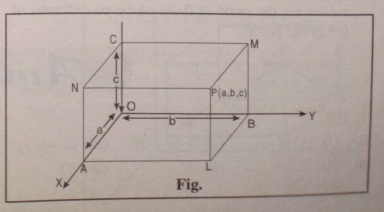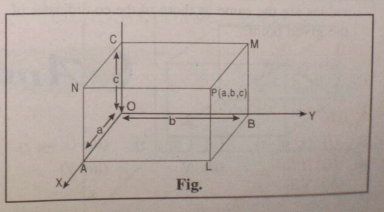Complete Solutions to EXAMPLE of chapter INTRODUCTION TO THREE DIMENSIONAL GEOMETRY of Class 11 book with complete answers and questions
| Class 11 | MATHS |
| Chapter | INTRODUCTION TO THREE DIMENSIONAL GEOMETRY |
| MODERN PUBLICATION | EXAMPLE |
| Number Of Questions | 30 |
| Academic Year | 2023-24 |
In the figure, if P is (a, b, c), find the co-ordinates of A, B, C and L, M, N.
 02:29View Solution
02:29View SolutionIn the figure, if P is (2, 4, 5), find the co-ordinates of N.
 01:06View Solution
01:06View SolutionIn the figure, find the co-ordinates of the reflection (image) of P in the XY-plane.
 01:09View Solution
01:09View SolutionName the octant in which the following points lie : (1, 2, 3).
01:34View SolutionName the octant in which the following points lie : (4,-2,3).
01:52View SolutionName the octant in which the following points lie : (4,-2,-5).
02:25View SolutionName the octant in which the following points lie : (4, 2, - 5) .
00:51View SolutionName the octant in which the following points lie : (- 4, 2, - 5).
01:55View SolutionName the octant in which the following points lie : (-4, 2, 5).
03:03View SolutionName the octant in which the following points lie : (- 3, -1, 6).
00:45View SolutionName the octant in which the following points lie : (2, - 4, - 7).
00:41View SolutionFind the distance between points : A(2,3,5) and B (4, 3, 1).
01:31View SolutionFind the value of x, so that the point (6,5,-3) is at a distance of 13 units from the point (x,-7,0).
02:10View SolutionFind the point on the Y-axis, which is equidistant from the points (3, 1, 2) and (5, 5, 2).
02:48View SolutionUsing distance formula, show that the points A(-3, 2, 4), B(- 1, 5, 9) and C (1, 8, 14) are collinear.
03:53View SolutionShow that the triangle with vertices (6, 10, 10), (1, 0, - 5) and (6, - 10, 0) is a right-angled triangle.
03:53View SolutionShow that the points : A (0,1,2),B(2,-1,3) and C (1,-3,1) are vertices of an isosceles right angle triangle.
05:06View SolutionShow that the points (5, - 1, 1),(7, - 4, 7), (1, - 6, 10) and (- 1, -3, 4) are the vertices of a rhombus.
06:03View SolutionFind the co-ordinates of the point, which is equidistant from four points (0, 0, 0), (a, 0, 0), (0, b, 0) and (0, 0, c).
04:09View SolutionFind the equation of the set of points P such that its distances from the points A (3, 4, - 5) and B (- 2, 1, 4) are equal.
02:59View SolutionFind the co-ordinates of the point, which divides the line segment joining the points (5, 4, 2) and (-1, -2, 4) in the ratio : 2:3 .
03:28View SolutionFind the co-ordinates of the point, which divides the line segment joining the points (5, 4, 2) and (-1, -2, 4) in the ratio : 2:3 .
03:28View SolutionFind the co-ordinates of the point R, which divides [PQ] externally in the ratio 2: 1 and verify that Q is the mid-point of PR.
01:38View SolutionA point R with x-co-ordinate 4 lies on the line segment joining the points P(2,-3,4) and Q(8,0,10). Find the co-ordinate of the point R.
03:27View SolutionFind the ratio in which the plane `3x+ 4y-5z =1` divides the line joining the points (-2, 4, -6) and (3, - 5, 8).
01:50View SolutionUsing section formula, prove that the three points (- 4, 6, 10), (2, 4, 6) and (14,0,-2) are collinear.
10:05View SolutionA (3, 2, 0), B(5, 3, 2), C(- 9, 6, -3) are three points forming a triangle. AD, the bisector of `anlge BAC` meets [BC] at D. Find the co-ordinates of D.
01:38View SolutionShow that the points (3, -1, -1), (5,-4, 0), (2, 3, -2) and ( 0, 6, -3) are the vertices of a parallelogram*.
06:26View SolutionFind the third vertex of the triangle whose centroid is (7, -2, 5) and whose other two vertices are (2, 6,-4) and (4, -2, 3).
02:37View SolutionProve that the lines joining the vertices of a tetrahedron to the centroids of the opposite faces are concurrent.
04:10View Solution
EXAMPLE questions and complete solutions for chapter INTRODUCTION TO THREE DIMENSIONAL GEOMETRY of MODERN PUBLICATION of Class 11
